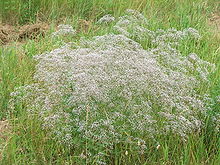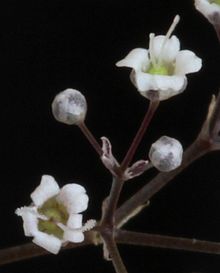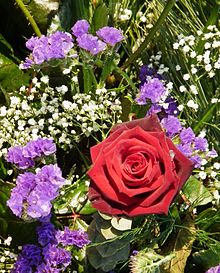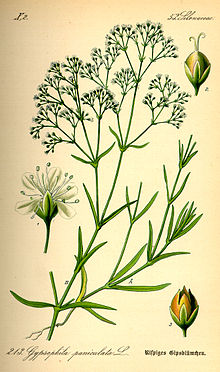- Gypsophila paniculata
-
Common Baby's-breath 
Gypsophila paniculata Scientific classification Kingdom: Plantae (unranked): Angiosperms (unranked): Eudicots (unranked): Core eudicots Order: Caryophyllales Family: Caryophyllaceae Genus: Gypsophila Species: G. paniculata Binomial name Gypsophila paniculata
L.Gypsophila paniculata, commonly known as Baby's-breath, is a cultivated ornamental garden plant in the Caryophyllaceae family, popular in the florist trade (see illustration) to provide a background for more colourful flowers.
Originally from Eastern Europe, its natural habitat is on the Steppes in dry, sandy and stony places, often on calcareous soils (gypsophila = "chalk-loving"). Specimens of this plant were first sent to Linnaeus from St Petersburg by the Swiss-Russian botanist Johann Amman. It is cultivated in Peru corresponding to a large portion of this country's flowers exports. [1]
Invasive
Gypsophila paniculata is now widely distributed in North America. [2] It is classed as an invasive species in places around the Great Lakes, such as the Sleeping Bear Dunes National Lakeshore [3] and the Chicago region, [4] and in the Pacific Northwest. [5]
References
- ^ La floricultura en el Perú: La más alta calidad en Gypsphila
- ^ PLANTS Profile - Gypsophila paniculata L. - baby's breath, PLANTS Database, U.S. Department of Agriculture. Retrieved 6 July 2010.
- ^ Does removal of Baby’s Breath from Lake Michigan sand dunes restore native plant diversity and ecosystem function?, The Nature Conservancy. Retrieved 6 July 2010.
- ^ Invasive Plants in the Chicago Region, Chicago Botanic Garden.
- ^ Pacific Northwest Noxious Weed List, Pacific Northwest Invasive Plant Council. Retrieved 6 July 2010.
Categories:- Caryophyllaceae
- Medicinal plants
- Caryophyllales stubs
Wikimedia Foundation. 2010.



